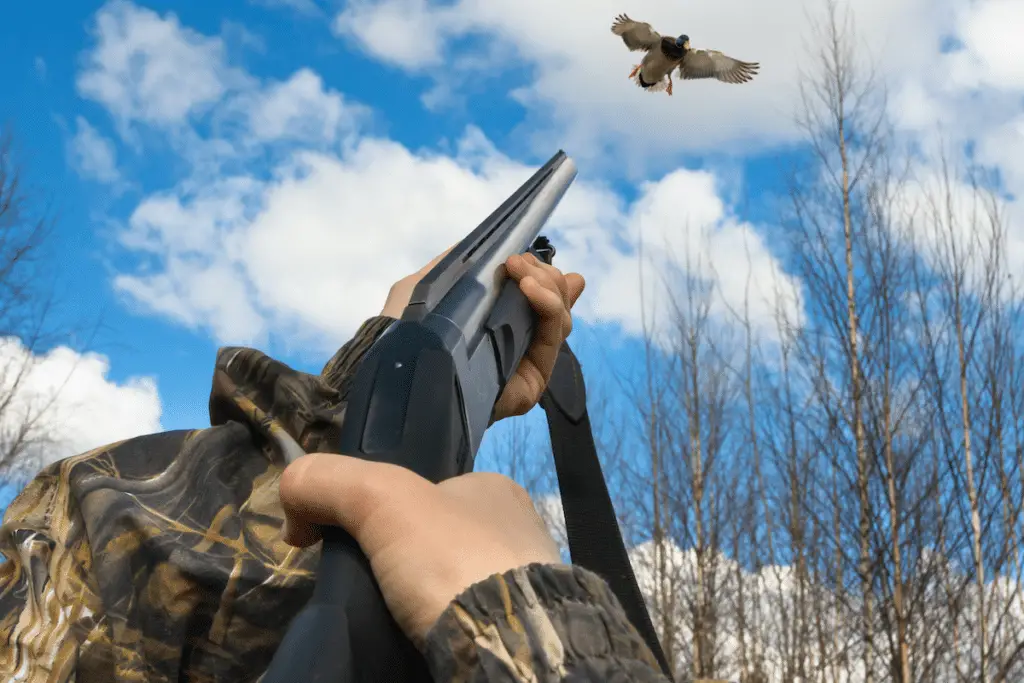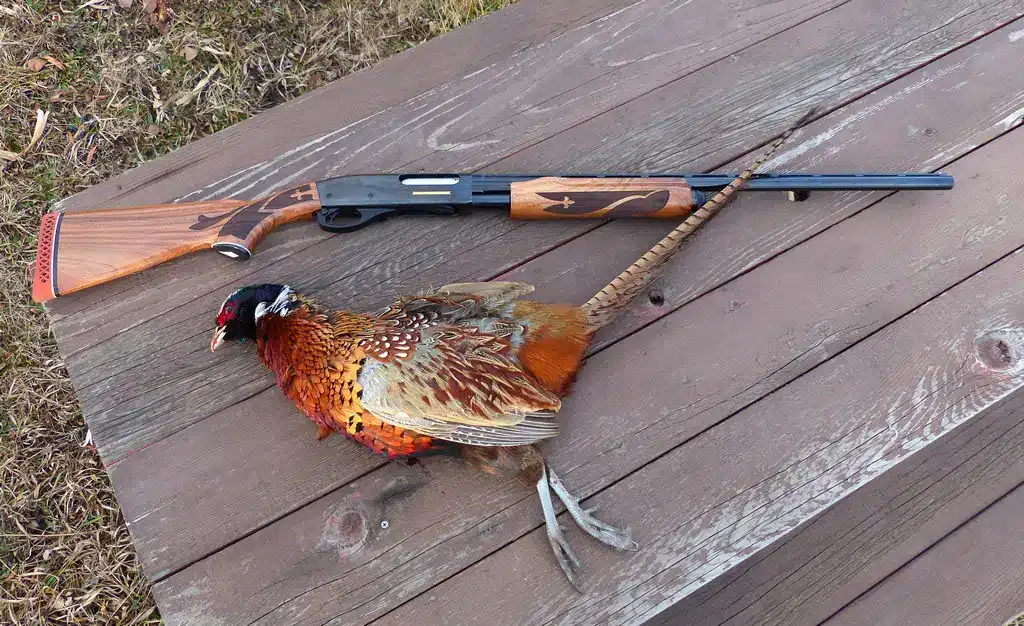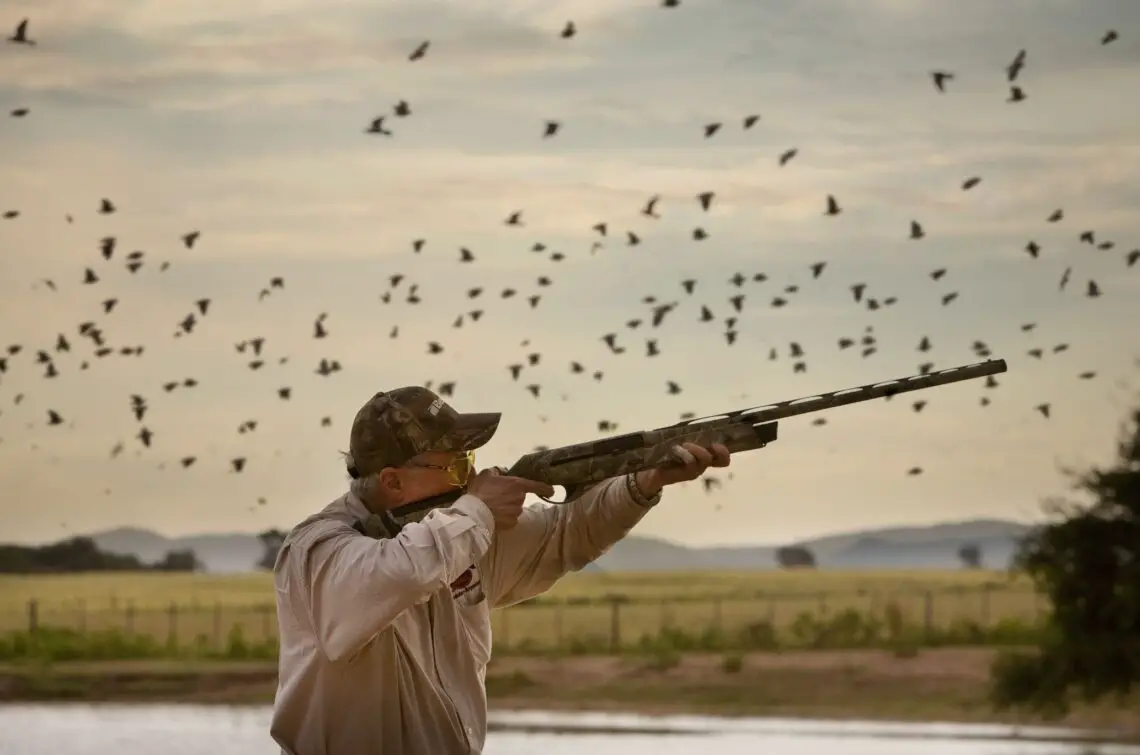Which Two Shotgun Chokes Are Best For Hunting Small Birds: When it comes to hunting small birds, having the right shotgun choke can make all the difference. A shotgun choke is a device that is inserted at the end of the barrel to control the spread of the shot. It helps to concentrate the pellets in a tighter pattern, increasing the chances of hitting the target. However, with so many different types of chokes available, it can be overwhelming to choose the best ones for hunting small birds.
One of the most popular shotgun chokes for hunting small birds is the improved cylinder (IC) choke. This choke has a moderate constriction, allowing for a wider shot pattern at shorter distances. It is ideal for hunting birds that are flying close to the ground, such as quail or grouse. The wider shot pattern gives you a better chance of hitting the target, even if your aim is slightly off. The IC choke is also versatile, as it can be used for shooting at longer distances as well, making it a great all-around choice for small-bird hunting.
Another excellent choice for hunting small birds is the modified (M) choke. This choke has a slightly tighter constriction than the IC choke, resulting in a denser shot pattern. It is perfect for hunting birds that are flying at medium distances, such as pheasants or ducks. The tighter shot pattern increases the chances of hitting the target, especially when the birds are flying in a straight line. The modified choke is also effective for shooting at longer distances, making it a versatile option for small-bird hunting.
Ultimately, the best shotgun chokes for hunting small birds will depend on various factors, including the type of bird, the distance of the shot, and personal preference. It is important to experiment with different chokes and see which ones work best for you. Remember to always follow safety guidelines and regulations when hunting, and happy hunting!
What is the best shotgun choke for birds?

Improved cylinder and modified are the two shotgun chokes are best for hunting small, fast, close birds.
Shotgun chokes are devices that are used to control the spread of shot pellets when firing a shotgun. They are essentially tubes that are inserted into the muzzle of the shotgun and can be either fixed or interchangeable. The purpose of a shotgun choke is to tighten or widen the pattern of the shot, depending on the type of shooting being done. When it comes to bird hunting, choosing the right shotgun choke is crucial for success.
There are several factors to consider when selecting the best shotgun choke for birds. The first is the type of bird being hunted. Different species of birds have different flight patterns and sizes, so it’s important to choose a choke that will provide the appropriate pattern for the specific bird being targeted. For example, a tighter choke may be more suitable for smaller birds like quail or dove, while a wider choke may be better for larger birds like pheasant or turkey.
The second factor to consider is the distance at which the birds will be shot. If the birds are going to be shot at close range, a wider choke may be more effective in providing a larger pattern and increasing the chances of hitting the target. On the other hand, if the birds are going to be shot at longer distances, a tighter choke may be necessary to ensure a denser pattern and better accuracy.
The third factor to consider is personal preference and shooting style. Some hunters prefer a specific choke based on their shooting style and comfort level. For example, some hunters may prefer a more open choke for faster, closer shots, while others may prefer a tighter choke for longer, more precise shots. It’s important to experiment with different chokes and find the one that works best for you.
In conclusion, selecting the best shotgun choke for birds requires considering the type of bird being hunted, the distance at which the birds will be shot, and personal preference. It’s important to choose a choke that will provide the appropriate pattern for the specific bird being targeted and to experiment with different chokes to find the one that works best for you. With the right shotgun choke, you can increase your chances of success in bird hunting.
What choke is best for hunting small birds?
Someone hunting small, fast, close birds would generally use an Improved Cylinder or Modified choke, which creates a broad shot pattern that spreads quickly at close ranges.
When it comes to hunting small birds, choosing the right choke is crucial for achieving a successful hunt. The choke determines the spread of the shot pattern, which directly affects the accuracy and effectiveness of your shots. With a wide range of choke options available, it can be overwhelming to determine which one is best suited for hunting small birds.
Improved Cylinder (IC) choke: This choke is a popular choice for hunting small birds due to its wide shot pattern. It provides a good balance between pattern density and spread, making it ideal for close-range shots. The IC choke is particularly effective when hunting birds that flush quickly, as it allows for a wider margin of error.
Modified (M) choke: The Modified choke offers a slightly tighter shot pattern compared to the IC choke. It is a versatile option that can be used for various hunting situations, including small birds. The tighter pattern provides better range and accuracy, making it suitable for medium-range shots.
Full (F) choke: The Full choke is the tightest option available and is best suited for longer-range shots. It produces a dense shot pattern, ensuring maximum pellet concentration on the target. While it may not be the ideal choice for hunting small birds, it can be effective when targeting birds at a distance.
Improved Modified (IM) choke: This choke falls between the Modified and Full chokes in terms of shot pattern. It offers a tighter pattern than the Modified choke but not as tight as the Full choke. The IM choke is a versatile option that can be used for various hunting scenarios, including small birds at medium to long ranges.
Conclusion: When selecting a choke for hunting small birds, it is important to consider the distance at which you will be shooting and the behavior of the birds. The IC choke is a popular choice for close-range shots, while the Modified choke offers versatility for medium-range shots. The Full choke is best suited for longer-range shots, and the IM choke provides a balance between pattern density and spread. Ultimately, the best choke for hunting small birds will depend on your personal preference and the specific hunting conditions you encounter.
What shotgun choke is best for doves?
Skeet choke
Skeet choke is an excellent choice for early-season doves, followed up with improved-cylinder as the second-best option for dove hunters. For shooters using two-barrel shotguns, it’s hard to beat skeet for the first shot and improved-cylinder for the follow-up.
When it comes to hunting doves, choosing the right shotgun choke is crucial for a successful hunt. A shotgun choke is a constriction at the muzzle end of the barrel that controls the spread of the shot. Different chokes have different patterns, which determine the density and range of the shot. The right choke can help you achieve a tight pattern that increases your chances of hitting the fast-flying doves.
Improved Cylinder (IC) choke: The Improved Cylinder choke is a popular choice for dove hunting. It provides a moderate constriction, allowing for a wider shot pattern. This choke is ideal for close to medium-range shots, as it offers a good balance between pattern density and spread. The wider pattern helps compensate for the fast and erratic flight of doves, increasing the chances of hitting them.
Modified (M) choke: The Modified choke is another option that many dove hunters prefer. It offers a slightly tighter constriction than the Improved Cylinder choke, resulting in a denser shot pattern. This choke is suitable for medium-range shots, providing a good balance between pattern density and range. It offers a bit more precision than the Improved Cylinder choke, making it a reliable choice for dove hunting.
Full (F) choke: The Full choke is the tightest constriction commonly used for dove hunting. It produces a dense shot pattern with minimal spread, making it ideal for longer-range shots. However, it requires more accuracy and precision, as the tight pattern leaves less room for error. The Full choke is recommended for experienced shooters who are confident in their ability to consistently hit doves at longer distances.
Conclusion: In conclusion, the best shotgun choke for doves depends on the shooter’s preference, shooting style, and hunting conditions. The Improved Cylinder choke is a versatile choice that offers a good balance between pattern density and spread. The Modified choke provides a slightly tighter pattern, while the Full choke is suitable for longer-range shots. Ultimately, it is important to practice with different chokes and determine which one works best for you in order to maximize your success in dove hunting.
What is the best choke to use?
No particular choke is inherently better than another – it all depends on the range at which you are shooting as to what is the best choice for you. Ultimately you’re looking for a pattern with the greatest density of shot, without significant gaps or groups, at your chosen distance.
What is the best choke to use?
When it comes to choosing the best choke for your shotgun, there are several factors to consider. The choke you select can greatly impact the performance and effectiveness of your shots, so it’s important to choose wisely. In this article, we will explore the different types of chokes available and discuss their advantages and disadvantages.
Firstly, let’s start by understanding what a choke is. A choke is a constriction at the end of the shotgun barrel that controls the spread of the shot. It tightens the shot pattern, allowing for a more focused and accurate shot. Different chokes have different levels of constriction, which can be adjusted to suit different shooting situations.
One of the most common types of choke is the cylinder choke. This choke has no constriction and allows the shot to spread out quickly, resulting in a wide shot pattern. It is ideal for close-range shooting, such as hunting small game in dense cover. However, the wide shot pattern may not be suitable for long-range shooting or targets that require a more precise shot placement.
Another popular choke is the modified choke. This choke has a moderate constriction, providing a balance between shot spread and shot density. It is versatile and can be used for a variety of shooting situations, making it a popular choice among hunters and sports shooters. The modified choke is effective for medium-range shooting and can be used for both close and long-range targets.
If you are looking for a choke that offers a tighter shot pattern, the full choke might be the best option for you. This choke has a significant constriction, resulting in a dense shot pattern. It is ideal for long-range shooting and targets that require a high level of precision, such as trap shooting or skeet shooting. However, the tight shot pattern may not be suitable for close-range shooting or targets that require a wider spread.
What is the best choke for crows?
A modified or improved-cylinder choke, shotgun depending, is likely best for your plans. As shotgun loads go, No. 6 shot, to even No. 7 1/2s or 8s are a good bet.
When it comes to controlling the population of crows, using the right choke can make a significant difference. Crows are highly intelligent and adaptable birds that can cause various problems, including crop damage, noise pollution, and even attacks on smaller animals. Therefore, finding the best choke for crows is essential for effective population management.
Factors to consider:
There are several factors to consider when determining the best choke for crows. Firstly, it is important to understand the behavior and habits of crows. Crows are social birds that often gather in large groups, so a choke that can target multiple birds at once may be more effective. Additionally, crows are known for their intelligence, so using a choke that can outsmart their problem-solving abilities is crucial.
Types of chokes:
There are various types of chokes available for crow control. One popular option is the audio choke, which utilizes sound to deter crows. This can include loud noises, such as fireworks or distress calls of other birds, to scare away the crows. Another type is the visual choke, which uses visual deterrents like scarecrows or reflective surfaces to create an environment that crows find unappealing.
Another effective choke for crows is the physical choke. This can involve using nets or barriers to prevent crows from accessing certain areas, such as crops or nesting sites. Additionally, some physical chokes may involve the use of non-lethal traps to capture and relocate crows to more suitable habitats.
Choosing the best choke:
Choosing the best choke for crows depends on the specific situation and desired outcome. For example, if the goal is to protect crops, a combination of physical and visual chokes may be most effective. On the other hand, if the aim is to deter crows from urban areas, audio chokes that create a noisy and uncomfortable environment may be more suitable.
In conclusion, finding the best choke for crows requires considering factors such as crow behavior, intelligence, and the desired outcome. By understanding these factors and utilizing the appropriate chokes, it is possible to effectively manage the crow population and mitigate the problems they may cause.
Which two shotgun chokes are most effective when hunting small birds?
When it comes to hunting small birds, there are two shotgun chokes that are highly recommended for optimal results. The first one is the Improved Cylinder (IC) choke, which provides a wide and even spread pattern. This choke is ideal for close-range shots and is particularly effective when hunting birds that are flying in a tight formation. The wide pattern allows for a greater chance of hitting multiple birds with a single shot, increasing your chances of a successful hunt.
The second recommended choke for hunting small birds is the Modified (M) choke. This choke offers a slightly tighter pattern compared to the IC choke, making it suitable for medium-range shots. The tighter pattern helps to increase the effective range of your shotgun, allowing you to take down birds that are flying at a slightly greater distance. The Modified choke strikes a good balance between pattern density and range, making it a versatile choice for small bird hunting.
What are the ideal shotgun chokes to use when targeting small birds during a hunt?
When it comes to hunting small birds, there are a few shotgun chokes that are highly recommended for optimal results. The two most effective chokes for this type of hunting are the improved cylinder (IC) and the modified (M) chokes. These chokes provide a good balance between spread and density, allowing for a wider shot pattern while still maintaining enough pellet concentration to effectively take down small birds.
The improved cylinder choke is ideal for close-range shots, as it provides a wider shot pattern that is perfect for birds that are flying in close proximity. This choke allows for a greater margin of error, making it easier to hit fast-moving targets. On the other hand, the modified choke offers a slightly tighter shot pattern, making it suitable for medium-range shots. It provides a good balance between spread and density, allowing for accurate shots at birds that are a bit farther away.
Can you suggest the top two shotgun chokes for successful small-bird hunting?
When it comes to successful small bird hunting, there are two shotgun chokes that are highly recommended for optimal results. The first one is the Improved Cylinder (IC) choke. This choke has a slightly tighter constriction than the Cylinder choke, allowing for a more controlled shot pattern. It is ideal for close-range shooting and is particularly effective when hunting small birds in dense cover or thick vegetation. The IC choke provides a good balance between spread and density, making it a versatile choice for various hunting situations.
The second recommended choke for small bird hunting is the Modified (M) choke. This choke has a slightly tighter constriction than the IC choke, resulting in a denser shot pattern. It offers a good balance between spread and range, making it suitable for medium-range shooting. The Modified choke is effective for small bird hunting in open fields or areas with moderate cover. It provides a bit more range and accuracy compared to the IC choke, making it a popular choice among hunters.
Which shotgun chokes would you recommend for optimal results when hunting small birds?
When it comes to hunting small birds, there are a few shotgun chokes that are highly recommended for optimal results. The first choke that I would suggest is the improved cylinder (IC) choke. This choke has a slightly tighter constriction than the cylinder bore, allowing for a more focused shot pattern. The IC choke is ideal for close to mid-range shots, making it perfect for hunting small birds in dense cover or when they are flying in tight groups.
Another choke that I would recommend for small bird hunting is the modified (M) choke. This choke has a slightly tighter constriction than the IC choke, providing a denser shot pattern at longer distances. The modified choke is great for small birds that are flying at a moderate range, allowing for a better chance of hitting your target. It offers a good balance between a tight pattern and effective range, making it a versatile choice for various hunting situations.

Conclusion
When it comes to hunting small birds, choosing the right shotgun choke is crucial for a successful hunt. The choke of a shotgun determines the spread of the shot pattern, which directly affects the accuracy and effectiveness of your shots. With so many options available, it can be overwhelming to decide which chokes are best suited for hunting small birds.
Two shotgun chokes that are highly recommended for hunting small birds are the improved cylinder (IC) choke and the modified (M) choke. The improved cylinder choke has a slightly tighter constriction than the cylinder bore, allowing for a wider shot pattern. This choke is ideal for close-range shots and is particularly effective when hunting small birds in dense cover or thick vegetation. On the other hand, the modified choke has a slightly tighter constriction than the improved cylinder choke, resulting in a more focused shot pattern. This choke is versatile and can be used for both close-range and mid-range shots, making it suitable for various hunting situations.
The improved cylinder choke is particularly advantageous when hunting small birds that are known for their quick and erratic flight patterns. The wider shot pattern allows for a greater margin of error, increasing the chances of hitting the target even if the bird is moving rapidly. Additionally, the improved cylinder choke is less likely to damage the bird’s meat, as the shot spread is not as concentrated as with tighter chokes.
On the other hand, the modified choke offers a balance between a wide-shot pattern and a more focused one. This makes it suitable for hunting small birds that may be flying at different distances. The tighter constriction of the modified choke provides a longer effective range, allowing for accurate shots at slightly greater distances. However, it is important to note that the effective range of the modified choke may vary depending on the specific shotgun and ammunition used.





No Comments